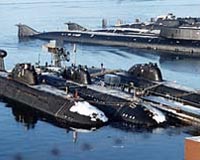 |
Washington (AFP) April 12, 2010 Ukraine pledged Monday to dispose of its stocks of highly enriched uranium by 2012, as the United States vowed to work with the nation still haunted by the Chernobyl accident over two decades ago. The surprise announcement came in a joint statement after US President Barack Obama met for the first time with Ukrainian President Viktor Yanukovych, who took office in the former Soviet republic in February. "President Yanukovych announced Ukraine's decision to get rid of all of its stocks of highly-enriched uranium by the time of the next Nuclear Security Summit," the two leaders said. Ukraine's promise to dispose of all highly enriched uranium by 2012 marked the first concrete achievement of an unprecedented nuclear security summit hosted by Obama in Washington and gathering 47 world leaders for two days. It was also a highly symbolic act by Ukraine, scene of the world's worst ever civilian nuclear accident in Chernobyl in 1986, and a country that has given up all of its Soviet-era nuclear missiles. The last nuclear warheads were removed in 1996 from Ukraine -- which inherited the world's third largest nuclear arsenal with the breakup of the Soviet Union, according to the Nuclear Threat Initiative (NTI). "President Obama praised Ukraine's decision as a historic step and a reaffirmation of Ukraine's leadership in nuclear security and nonproliferation," the joint statement said. It added that Kiev "intends to remove a substantial part" of its enriched uranium stocks this year. White House spokesman Robert Gibbs said the United States would help provide technical expertise and financing for the disposal of the uranium in Ukraine. He estimated the former Soviet Republic intended to get rid of some 90 kilos (180 pounds) of highly enriched uranium over the next two years. "I would say that, if my math is correct, there's roughly 90 kilograms. I'm under the impression that it's actually more than that," Gibbs said. "I don't want to get into a specific amount. It's enough, as I said, for the construction of several nuclear weapons." Kiev also joined Washington "in the international effort to convert civil nuclear research facilities to operate with low enriched uranium fuel, which is becoming the global standard in the 21st century," the joint presidential statement said. The two leaders also "agreed to explore ways to strengthen cooperation in the peaceful uses of atomic energy, including development of Ukrainian nuclear research capabilities and efforts to diversify Ukraine's nuclear power industry's fuel supply." And "they also agreed to continue working together on nuclear safety, including efforts to safeguard the Chernobyl nuclear reactor site." The Chernobyl disaster occurred on April 26, 1986 at 1:23 am, when one of the reactors exploded -- contaminating the then-Soviet states of Ukraine, Russia and Belarus, with the fallout also spreading to other parts of Europe. More than 25,000 people known as "liquidators" -- most of them Ukrainians, Russians and Belarussians -- died getting the accident under control and constructing a concrete shield over the wreckage, according to Ukrainian official figures. A United Nations toll published in September 2005 set the number of victims at just 4,000, a figure challenged by non-governmental organizations. In Ukraine alone, 2.3 million people are designated officially as "having suffered from the catastrophe." Some 4,400 Ukrainians, children or adolescents at the time of the accident, have undergone operations for thyroid cancer, the most common consequence of radiation, the health ministry says. Despite the dangers still posed by civilian nuclear energy, the Washington summit is more focused on the need to keep nuclear material out of the hands of extremists. Obama is hoping to win pledges on securing loose nuclear material in weapons, atomic reactors and stockpiles within four years. Top powers were to hold two days of talks on the increasingly diffuse nuclear threat, focusing especially on stocks of separated plutonium and enriched uranium which could be used by militant groups to manufacture crude, but devastating weapons.
Share This Article With Planet Earth
Related Links Nuclear Power News - Nuclear Science, Nuclear Technology Powering The World in the 21st Century at Energy-Daily.com
 Nuclear twist: when Russia's old warheads warm US homes
Nuclear twist: when Russia's old warheads warm US homesWashington (AFP) April 11, 2010 In a strange twist of Cold War enmity on the melt, uranium from what once were Russian nuclear warheads is used to heat and light American homes, thanks to the Megatons to Megawatts Program - a successful example of nuclear non-proliferation. The 20-year agreement was signed back in 1994 between Russia and the United States. "Megatons to Megawatts is the most successful non-proliferatio ... read more |
|
| The content herein, unless otherwise known to be public domain, are Copyright 1995-2010 - SpaceDaily. AFP and UPI Wire Stories are copyright Agence France-Presse and United Press International. ESA Portal Reports are copyright European Space Agency. All NASA sourced material is public domain. Additional copyrights may apply in whole or part to other bona fide parties. Advertising does not imply endorsement,agreement or approval of any opinions, statements or information provided by SpaceDaily on any Web page published or hosted by SpaceDaily. Privacy Statement |